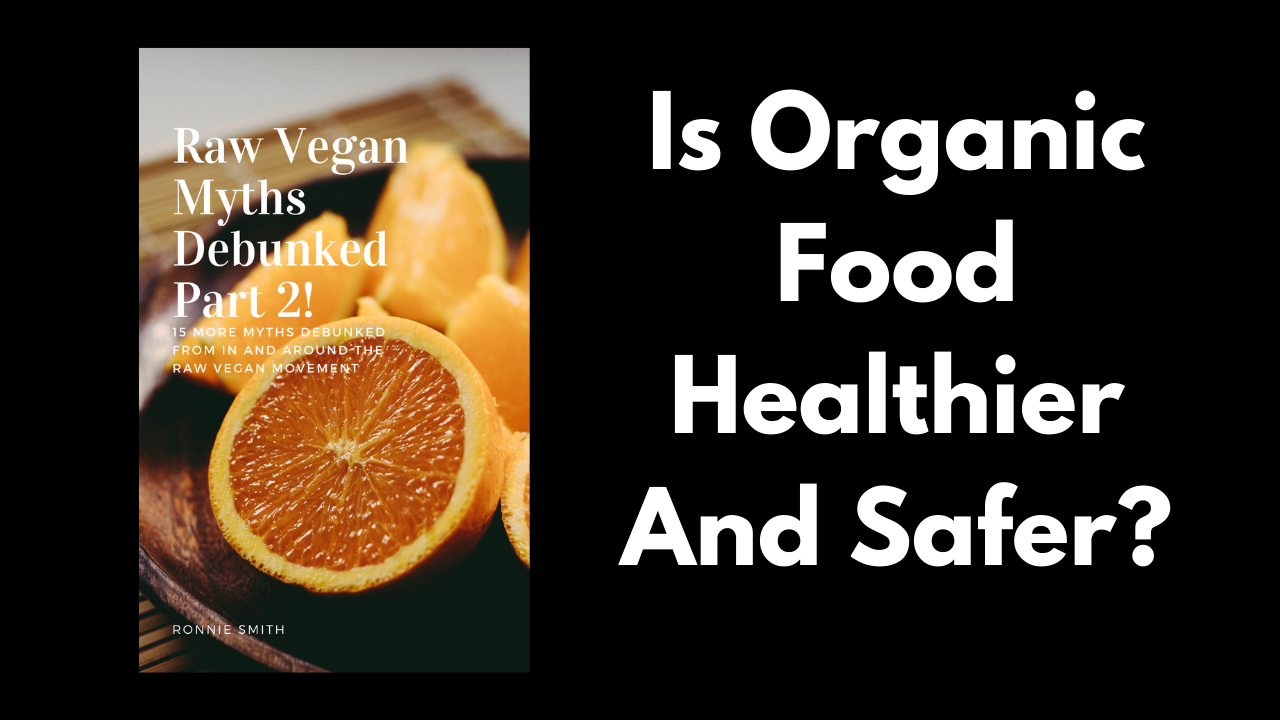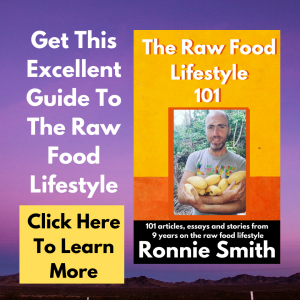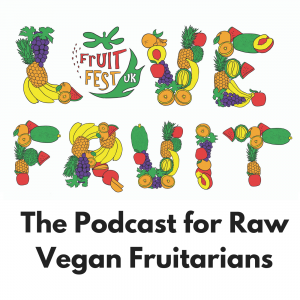Organic Food – Is It Healthier And Safer?
by Ronnie Smith

This article is an excerpt from the book “Raw Vegan Myths Debunked” currently available for a short period of time as part of the Ultimate Raw Vegan Bundle. You can find more information about that here: click here to find out more
A widely held assumption in the raw vegan movement is that organic foods are better for our health and better for the health of the planet. Certainly, this idea feels intuitively right. Surely, it must follow that foods that have not been sprayed with toxic chemicals would be healthier for us and that the soils they grow on would flourish more healthfully also.
The argument I have heard a number of times is that we should not even have to use the label “organic food”. After all, the use of pesticides is a relatively recent occurrence. Throughout history, the majority of food we have eaten has been “organic” and therefore technically it should just be labelled “food”.
Instead, it is said that conventionally grown food should be called “pesticide food” or “toxic food”.
This could be the case if the term “organic” meant what most supporters of organic food think it means. Perhaps the reality is different, and we will look at this more in this section.
Common attitudes towards organic food appear to be:
- Organic food is more nutritious and more healthy for us
- Organic farming is better for the environment and less polluting
- Organic food is not sprayed with chemicals
- Organic farming is less harmful to animals and insect life
- Organic farming is less harmful for the soil
If these claims are true, then it would be easy to see why people would choose organic over conventional food. To begin to address this idea, my first question is what exactly does “organic” mean and what is organic food?
In this section I will not only look into this but also look at the available evidence on how healthy organic food is for us in comparison to conventional food. Specifically I want to look at the following ideas:
- “Organic” means no pesticides
- “Organic” means no synthetic chemicals
- Organic farming is less harmful to the environment
- Organic foods are healthier and more nutritious for us
- Conventional foods are full of toxic pesticide residues
- We should follow the Dirty Dozen List
What does the term “Organic” mean?
Two definitions of “organic” are found easily using a Google search. These definitions come from Oxford Languages.
- relating to or derived from living matter.
- (of food or farming methods) produced or involving production without the use of chemical fertilizers, pesticides, or other artificial chemicals.
The definition from Cambridge Dictionary is:
“not using artificial chemicals in the growing of plants and animals for food and other products”
While Merriam Webster gives its definition as:
“of, relating to, yielding, or involving the use of food produced with the use of feed or fertilizer of plant or animal origin without employment of chemically formulated fertilizers, growth stimulants, antibiotics, or pesticides”
What we will find later in this section is that none of these definitions are entirely accurate. A better definition would be that the word organic relates to food that is grown using a particular set of farming standards.
The Standards of Organic Farming
In the UK, the Soil Association is “the UK’s largest organic certification body.” They produce an annual report on the growth of the organic market for their members. In their 2021 report, they state that the total organic food market in the UK is now worth £2.79 billion which is a rise of 12.6% from the previous year.
It is an approved organic control body as defined by the UK Government. Formed in 1946, it is based on 4 principles:
“The Principle of Health – Organic agriculture should sustain and enhance the health of soil, plant, animal and human as one and indivisible.
The Principle of Ecology – Organic agriculture should be based on living ecological systems and cycles, work with them, emulate them and help sustain them.
The Principle of Fairness – Organic agriculture should build on relationships that ensure fairness with regard to the common environment and life opportunities.
The Principle of Care – Organic agriculture should be managed in a precautionary and responsible manner to protect the health and well-being of current and future generations and the environment”.
On top of these principles they have set certain standards that farmers and suppliers must meet in order to gain their organic certification. These standards go above and beyond standards set in other countries.
Initially, their standards had to at least match those set by the EU (despite the fact that the Soil Association pre-dates EU rules on organic production and the UK’s membership of the EU which ended recently with Brexit), so let’s look at these first.
EU Standards of Organic Production
The key principles for the EU in organic food production are:
- prohibition of the use of GMOs; (Genetically Modified Organisms)
- forbidding the use of ionising radiation;
- limiting the use of artificial fertilisers, herbicides and pesticides;
- prohibiting the use of hormones and restricting the use of antibiotics to only when necessary for animal health.
To this end, they encourage organic farmers and suppliers to go towards practices such as:
- crop rotation;
- cultivation of nitrogen fixing plants and other green manure crops to restore the fertility of the soil;
- prohibition of use of mineral nitrogen fertilisers;
- to reduce the impact of weeds and pests, organic farmers choose resistant varieties and breeds and techniques encouraging natural pest control;
- encourage the natural immunological defence of animals;
- In order to maintain animal health, organic producers need to prevent overstocking.
The Soil Association (UK Standards)
The soil association claims to have set the first organic standards in the world in the 1960’s. They have a number of standards relating to different aspects of organic food production. The standards that are most relevant to raw vegans would be the following:
- To produce food of high quality and in sufficient quantity by the use of processes that do not harm the environment, human health, plant health or animal health and welfare.
- To work within natural systems and cycles at all levels, from the soil to plants and animals.
- To maintain the long-term fertility and biological activity of soils
- To design and manage organic systems which make the best use of natural resources and ecology to prevent the need for external inputs. Where this fails or where external inputs are required, the use of external inputs is limited to organic, natural or naturally derived substances.
- To limit the use of chemically synthesised inputs to situations where appropriate alternative management practices do not exist, or natural or organic inputs are not available, or where alternative inputs would contribute to unacceptable environmental impacts.
- To exclude the use of GMOs and products produced from or by GMOs with the exception of veterinary medicinal products.
These standards are certainly virtuous and ethical. But should we assume that many of these standards are not in line with what any farmer would want to achieve?
Why would a farmer want to actively damage their soil? Why would they wish to spend extra money on unnecessary inputs (pesticides and fertilisers)? What sense would it make for them to work a farm in such a way that would make the land infertile and useless in the future?
Would any farmer set out to actively harm human health or the environment? Is that really their goal?
The real difference here in organic standards is in the use of pesticides and other forms of plant protection. The organic standards have particular rules about what can be used to protect plants and help them grow.
Organic Does Not Mean “NO PESTICIDES”
Search Google for the definition of pesticide and you will find this:
a substance used for destroying insects or other organisms harmful to cultivated plants or to animals.
In reality, pesticide type products can be a little more complicated than simply killing pests. They can be substances that prevent pests from eating or harming crops in a number of different ways.
The Food and Agriculture Organisation of The United Nations (FAO) adds this to their definition of pesticide:
“Pesticides are any substance or mixture of substances of chemical or biological ingredients intended for repelling, destroying or controlling any pest, or for regulating plant growth. The term pesticide applies to insecticides, herbicides, fungicides, rodenticides, molluscicides, wood preservatives and various other substances used to control pests. Pesticides also include plant growth regulators, defoliants and desiccants.”
The organic standards do not entirely limit the use of pesticides. If you think that the label of “organic” means “unsprayed” or completely untampered with by the application of chemicals, this is incorrect.
The Soil Association and organic standards in general encourage the use of designing a farm to prevent the need for the use of any pesticides but do not entirely limit their use. The use of any substances as pesticides must be recorded.
Pesticides That Are Allowed In Organic Farming
The Soil Association includes a list of pesticides that are allowed to be used. Here is a list of the allowed pesticides:
- Allium sativum (Garlic extract)
- Azadirachtin extracted from Azadirachta indica (Neem tree)
- Beeswax (only as pruning agent/wound protectant)
- COS-OGA
- Eugenol, preferably of natural origin
- Geraniol, preferably of natural origin
- Hydrolysed proteins excluding gelatine
- Laminarin
- Maltodextrin
- Pheromones, only in traps and dispensers
- Plant oils, all uses authorised, except herbicide.
- Pyrethrins, only from plant origin
- Quassia (extracted from Quassia amara, only as an insecticide)
- Cortex (aka willow bark extract)
- Thymol, preferably of natural origin
- Lecithins
- Sucrose
- Fructose
- Vinegar
- Whey
- Equisetum arvense L.
- Chitosan hydrochloride (Obtained from sustainable fisheries or organic aquaculture)
- Spinosad, not from GMO origin
- Cerevisane, not from GMO origin
- Aluminium silicate (Kaolin)
- Calcium hydroxide (Fungicide, only in fruit trees including nurseries)
- Nectria galligena
- Carbon dioxide
- Copper hydroxide
- Copper oxychloride
- Copper oxide
- Bordeaux mixture
- Tribasic copper sulphate
- Diammonium phosphate, only as attractant in traps
- Ethylene
- Fatty acids,all uses authorised, except herbicide
- Ferric phosphate (iron (III) orthophosphate), preparations to be surface-spread between cultivated plants.
- Hydrogen peroxide, for seed treatment of lettuce and ornamentals and for disinfection of agricultural cutting tools used in Solanaceae.
- Kieselgur (diatomaceous earth)
- Lime sulphur (calcium polysulphide)
- Paraffin oil
- Potassium and sodium hydrogen carbonate (aka
- Potassium/sodium bicarbonate)
- Pyrethroids (only deltamethrin or lambdacyhalothrin) only in traps with specific attractants; only against Bactrocera
- Oleae and ceratitis capitata wied
- Quartz sand
- Sodium chloride (All uses authorised, except herbicide)
- Sulphur
This complete list and further details on current organic standards are available to download as part of the document “Soil Association Organic Standards For Great Britain: Farming And Growing”.
Do Organic Standards Do Allow For Synthetic Pesticides?
The allowed organic pesticides are mostly non-synthetic (not synthesised by human intervention) and derived more simply from natural ingredients. However the Soil Association does allow for limited use of some synthetic pesticides also:
“Soil Association standards allow organic farmers restricted use of seven non synthetic pesticides that have been approved on the basis of their origin, environmental impact and potential to persist as residues. They are copper ammonium carbonate; copper sulphate; copper oxychloride; sulphur; pyrethrum; soft soap and derris (rotenone).”
The assumption would be that these pesticides (being suitable for an organic standard) would be less harmful to humans and healthier for the environment.
Is this true?
Are Organic Pesticides Less Harmful And Better For The Environment?
In it’s 2001 Policy Report “Myth And Reality- Organic Vs Non Organic:The Facts” the Soil Association argues against the claim that organic farming uses pesticides that damage the environment.
They emphasise that organic farms are encouraged to use organic systems to reduce the need for the use of pesticides. The organic ethos is one of prevention rather than cure.
However, they do admit that pesticides, including seven synthetic pesticides (mentioned above), are permitted in organic agriculture. They provide no specific evidence around how much less harmful these pesticides are for the environment or for human health.
After all, a pesticide is a pesticide and they either interfere with or outright kill the small pests or other lifeforms that wish to consume our food supply. To assume that organic pesticides are not toxic, simply because they are more natural does not really make sense. They are toxic by definition but how do they compare generally to synthetic pesticides?
Science writer Christie Wilcox tackled the subject of organic food in an article for Scientific American entitled “Mythbusting 101: Organic Farming > Conventional Agriculture”
In this article, the author brings up a lot of evidence which contradicts commonly held ideas around organic farming. One of the most interesting parts of the article is on the perceived greater level of safety of organic pesticides. In fact she points out that the “natural” pesticides may have serious health risks.
Rotenone
Rotenone, one of the allowed organic pesticides listed above, comes from the roots of tropical plants. She writes:
“Research has shown that rotenone is highly dangerous because it kills by attacking mitochondria, the energy powerhouses of all living cells. Research found that exposure to rotenone caused Parkinson’s Disease-like symptoms in rats”
Temporarily, due to some of these concerns, Rotenone was banned for use in the US but is now allowed again.
Should we be worried about this? Most likely, no. As the levels remaining on any food will most likely be far below the safe limits (it is hard to know for sure as regular pesticide testing carried out by the government does not test for organic pesticide residues). But it is important to point out that the chemicals used in organic farming can be just as toxic.
Organic Farming Is Not Necessarily Less Harmful To The Environment
What about their harm to the environment? We are often told that unlike synthetic pesticides, the organic ones break down quicker and cause little harm to the environment. Is this the case?
It turns out it is not as simple as this. Wilcox points out one study proving this:
“Canadian scientists pitted ‘reduced-risk’ organic and synthetic pesticides against each other in controlling a problematic pest, the soybean aphid. They found that not only were the synthetic pesticides more effective means of control, the organic pesticides were more ecologically damaging, including causing higher mortality in other, non-target species like the aphid’s predators”
In a follow up article defending her initial piece, she goes into further details about the comparative toxicity and effectiveness of organic pesticides vs synthetic.
Copper Sulfate
Firstly, she makes a comparison between Copper Sulfate, an allowed organic pesticide and Chlorpyrifos, one of the most used synthetic pesticides in the USA. How do these compare?
One way to compare is to look at the LD50 (Lethal Dose At 50% – the dose at which 50% of a population of a species would die). In rats, the LD50 for Copper Sulfate is 30mg per kg of body weight. She points out that at lower doses Copper Sulfate can lead to harmful reactions:
“copper sulfate has also been shown to have chronic effects at lower doses of exposure. In animals, chronic exposure has led to anemia, stunted growth, and degenerative diseases. Furthermore, copper sulfate has been shown to disrupt reproduction and development, including inhibition of sperm development, loss of fertility, and lasting effects from in-utero exposure. Copper sulfate is also mutagenic and carcinogenic. And because copper is a trace element, it is strongly bioaccumulated, meaning consistent low doses can lead to toxic levels. In people, increased exposure has been linked to liver disease and anemia”
As for Chlorpyrifos, the LD50 is 95mg to 270mg per kg of body weight for rats which makes it 2.5 to 10 times less toxic than Copper Sulfate. Predictably this leads to less harmful symptoms found:
“As for its chronic effects, dogs fed chlorpyrifos at high doses daily did show increased liver weight and cholinesterase inhibition, meaning potential for neurological toxicity. But the effects went away immediately when feeding was stopped, and no long-term health effects were seen in either the dog or a similar rat study. Furthermore, no evidence of mutagenicity was found in any of four tests reviewed by EPA. It’s also not considered carcinogenic – rats and mice fed high doses for two years showed no increases in tumor growth”
Surprisingly, unlike Copper Sulfate, Cholpyrifos does not build up in the human body to toxic levels. They have been shown to be eliminated rapidly from the body within a day or so.
Both are pesticides, and must be controlled in how they are used. Both lead to toxic side effects. But what this shows is one example in which the organic pesticide is not immediately better simply due to being more natural.
Pyrethrum
The next comparison made was between two fungicides; Pyrethrum (an organic fungicide) and Chlorothanlonil (a synthetic). The Pyrethrum has an LD50 of 200mg per kg to 2000mg per kg. A lethal dose can lead to tremors, convulsions and paralysis prior to death.
The LD50 of Chlorothanlonil is more than 10,000mg per kg (5 to 50 times less toxic than the organic alternative). In some studies, rats fed a high dose of Chlorothanlonil over time showed no effects on physical appearance, behaviour or survival. Some showed the potential to act as a mutagen and carcinogen but this is also the case with Pyrethrum which has been shown to have the potential to increase the risk of tumours.
When we look at the effects on other species, we find that Pyrethrum is harmful to bees, wasps and to birds, while Chlorothanlonil is not.
It would appear that we can not make a clear argument then that organic pesticides and therefore organic farming is better for the environment and less toxic for us.
Land Use And Organic Farming
Another issue when it comes to the environmental impact is the amount of land that is required to grow food. In general, we agree that the least land used to produce food would be best as this would allow for a greater amount of land to go back to a natural ecosystem.
But organic farms are routinely shown to have lower yields:
“Organic farms produce around 80% that what the same size conventional farm produces (some studies place organic yields below 50% those of conventional farms!).”
If we change to a fully organic world, we would need to use far more land, perhaps even twice as much to produce the food that we do now.
This would also impact global hunger and starvation. With many peoples around the world experiencing hunger (estimates suggest around 800 million annually) and many millions dying from hunger each year, relying on a less productive food system could put an even greater number of people into a vulnerable situation.
This is the bigger picture that the hardcore supporters of organic seem to forget. We are not using these chemicals for fun. The history of the human race has been full of famine, crop failures and wars resulting from those desperate situations. Using these chemicals, though perhaps not ideal, may be completely essential to the health and peace of billions of people.
Perhaps this is a compromise we should be more relaxed about given this larger context?
Organic Foods Are Not Healthier Or More Nutritious
Those who promote organic foods have done a good job in making the public associate organic foods with health. Many people believe that organic foods are healthier for 2 key reasons.
- Organic farming leads to foods that are more nutritious, healthy and flavourful to humans
- Organic farming leads to less exposure to synthetic chemicals which are capable of causing harm to human health
These ideas are commonly thought to be the case. But what does the available scientific data show about the health benefits of organic foods vs conventionally grown foods?
Disappointingly, for the organic enthusiasts, there does not seem to be much evidence to support the idea that organic foods are healthier. In fact, it would appear that over and over, comprehensive reviews and meta analyses show there to be no major difference in either the nutritional content of organic foods or the health benefits that come from eating them.
Going back almost 100 years, articles have been published looking at the health benefits of organically grown food versus conventional foods. There have been a number of comprehensive reviews of the literature to find how strong the evidence is for the claims that organic foods are healthier than conventional.
A review from 1997 published in the Journal Of The Science Of Food and Agriculture looked at over 150 articles. It concluded that in comparing organically grown versus conventionally grown vegetables:
“with regard to all other desirable nutritional values…no major differences were observed”
A systematic review in the American Journal Of Clinical Nutrition stated that:
A 2021 systematic review in the Annals Of Internal Medicine looked at around 240 studies and concluded:
A more recent comprehensive review in the journal Environmental Health in 2017 concluded that:
“In conclusion, the link between organic food consumption and health remains insufficiently documented in epidemiological studies. Thus, well-designed studies characterized by prospective design, long-term duration and sufficient sample size permitting high statistical power are needed.”
In the United Kingdom, it appears to be the stance of the Food Standards Agency that:
The NHS (National Health Service) for the UK appears to suggest:
“There’s no scientific evidence that organic food is healthier”
Finally, one review assessing the claims made by the supporters of organic food is highly critical in its conclusions and worth adding here. The article “A Review Of The Nutrition Claims Made By Proponents Of Organic Food” written by Joseph D. Rosen looks at claims made and the evidence backing those claims. He states:
He goes on to make an even stronger set of claims:
“any members of the media who rely on organic food proponents for information without checking the facts are complicit in defrauding their readers. And any consumers who buy organic food because they believe that it contains more healthful nutrients than conventional food are wasting their money”
From this evidence, it would appear that we are unable to claim that organic foods have an improved effect on human health or that they are more nutritious. These studies do suggest that it would be difficult and expensive to create studies to prove this conclusively.
One problem is that people that eat more organic food tend to make other healthier choices which makes it hard to isolate whether the organic foods made any specific impact on their healthier outcomes. In the same sense, it is difficult to prove conclusively that a particular health detriment occurred as a result of the exposure to a particular pesticide or other.
Conventional Foods Are Not Full Of Pesticides Residues
One thing we can say is that organic foods do tend to have lower levels of trace synthetic pesticides. This should be the case as the only pesticides that are screened for generally are the synthetic pesticides which should not be used on organic crops. The organic pesticides however are not screened for on organic foods.
Could it be the case that there may be higher levels of the organic pesticides remaining on organic produce? It could be the case but we do not have the information to prove or disprove that until these pesticides are screened for.
In the UK, the Expert Committee On Pesticide Residues In Food (PRiF) is a government appointed committee that continually collects data and provides reports every quarter measuring the pesticide residues in the food supply in the UK.
In their 2020 report they state:
“We tested 2640 samples of food and drink available in the UK supply chain for pesticide residues. 58.46% of the samples tested by the laboratory did not have any residues we tested for and 2.52% of the samples contained a residue above the MRL (maximum residue limit) set by law”
For fruits and vegetables around 50% had no residues detected and this rose slightly to 53% for UK grown produce. 46.69% of samples tested had detectable amounts of pesticide below the MRL. 2.52% (dropping to 1.27% for UK grown produce) had a detectable amount above the MRL.
It should be noted that results above the MRL (maximum residue limit) are not necessarily cause for concern for the consumer. The committee confirms:
“Maximum Residue Levels (MRLs) are set in law at the highest level of pesticide that the relevant regulatory body would expect to find in that crop when it has been treated in line with Good Agricultural Practice (GAP). MRLs are trading standards rather than safety levels, therefore these results do not automatically mean the levels of residue detected are a risk to people’s health…MRL levels are often set far below levels that might otherwise be set just on consumer safety grounds alone”
In contrast, among 342 organic samples only 14 (4.09%) were found to have detectable levels of trace pesticides. Once again, it appears that the pesticides tested for were the synthetic varieties and that residues of organic pesticides are not being screened for.
In the USA, pesticide residues are monitored by the USDA’s Pesticide Data Program. The 2020 report found similar results to the UK:
“The summary shows that more than 99 percent of the samples tested had pesticide residues below benchmark levels established by the Environmental Protection Agency (EPA).”
30% of samples had no detectable results and only 0.49% had a result above the set tolerance limit.
Once again it appears that organic pesticide residues are not being tested for.
Plant pathologist Dr Steven Savage suggests:
“The USDA PDP residue-testing program is not set up to be able to detect most of the organic-approved pesticides such as sulfur, various copper salts, paraffinic oils, live biologicals and various plant extracts and microbial fermentation products. To do that would require expensive and specific assays and USDA has chosen not to do that.”
If consumers understood these figures, would it give them more confidence in the food supply? One publication that appears to have caused concern for consumers is the Dirty Dozen List. Should we follow its guidelines?
We Should Not Follow The Dirty Dozen List
The Dirty Dozen List is a famous list published annually by the Environmental Working Group as part of it’s “Shopper’s Guide To Pesticides In Produce” Publication. This guide also includes a Clean 15, the 15 most “clean” produce items.
This list has become massively influential and is well known around the world. It appears that many people recommend that this list is worth complying with to ensure that you are exposing yourself to the least pesticide residues. It appears to be taken seriously as a document that is scientifically credible (though not necessarily by the scientific community itself).
Unlike the USDA’s PDP publication or the Experts Committee For Pesticide Residues In Food (PRiF) annual reports which are created by Government backed organisations, the Environmental Working Group is a private organisation funded by private and corporate donors.
Essentially, they are a lobbying group based in Washington that act on behalf of among other groups the organic industry.
The actual Shopper’s Guide can be downloaded for free from their website (www.ewg.org) but it provides consumers with very little context or background on the information provided. Essentially, it allows a casual reader to make up their own mind and interpret the information provided as they wish.
They mention nothing about organic pesticides and that these are not being screened for. They mention nothing about potential environmental concerns around the use of these chemicals. They mention nothing about how far below the tolerance limits many of the pesticide residues detected are. They provide very little education to the consumer on this topic.
In his criticism of the Shopper’s Guide Dr Steven Savage suggests:
“While none of the crop residues are actually problematic, EWG’s methods actually rank produce incorrectly. Cauliflower, which EWG calls part of the “clean 15” and ranks as number 34 in their list, has more detections over 1/10th of the tolerance than other crops. Apples, which are the worst according to EWG, have 92% of detections below 1/10th of tolerance – better than many other crops. Canned beets, for which not even one detection was noted among 756 samples from 2011, doesn’t appear on EWG’s “Clean 15” list or in the list at all.”
This suggests it can not even be relied upon to interpret the data correctly. Is this really a list we should take seriously?
How Bad Is Conventional Food?
We have already seen the evidence to show that testing on conventional produce shows that 50% of samples taken in the UK and 30% in the US have no detectable pesticides. Of the remaining amount the far majority have detectable amounts below the tolerance limits (and much of that far, far below the tolerance limits). The remaining small amount that is above tolerance limits is not likely to be a cause for concern as these limits are set well below what would be a safe level for human health.
What is continually shared, even by those groups that promote organic produce, is that the consumption of fruits and vegetables far outweighs the risk of consuming these trace amounts of pesticides.
The Environmental Working Group suggests:
“Everyone should eat plenty of fresh fruits and vegetables, whether organic or conventionally grown. The health benefits of such a diet outweigh the risks of pesticide exposure.”
The Soil Association states:
“The best way of increasing one’s nutrient intake remains increasing consumption of fruits and vegetables, and the fresher the better.”
In his video, Pesticides and Cancer Risk, Dr Michael Greger of NutritionFacts.org puts it this way:
“concerns over pesticide risks should not discourage us from stuffing our faces with as many fruits and vegetables as possible. That would give us a huge health benefit, whereas the potential lifelong damage of any pesticides on those same fruits and veggies has been estimated to only cut a few minutes off a person’s life, on average, which is nothing compared to the nutritional benefits of eating more fruits and vegetables.”
It is important to point out that all of the mountains of research showing the healthy protective effects of fruits and vegetables have predominantly been conducted on conventionally grown fruit. The impact of conventional farming methods do not outweigh the tremendous health benefits that continue to be associated with higher intakes of fruits and vegetables.
Conclusions
Having looked further into the details around organic farming we can see that many publicly accepted ideas (and ideas promoted and taught by raw food educators and leaders) may not be correct. At the very least, there appears to be evidence that goes against many of these claims.
Myth – Organic Means Unsprayed
We have demonstrated that this is not correct. The organic ethos is to design crop systems that do not require sprays but in reality they are allowed (though certainly in a controlled fashion)
Myth – Organic means no synthetic chemicals
As has been shown, in some instances, synthetic chemicals are allowed in organic farming.
Myth – Organic farming is less harmful to the environment
Once again, the ethos of organic farming is to achieve this goal. But this idea may be called into question by the fact that some of the approved organic pesticides have been found to be worse for surrounding animal and insect species. More research will be required on this.
Myth – Organic farming is less taxing on our environment
Organic farms tend to produce lower yields. To feed the world with organic food we would require the use of more land. This would require more farm land being created by cutting down more natural ecosystems. Generally, environmentalists would agree that the least land used for farming the better.
Myth – Organic food is more nutritious and healthier for us
There is enough evidence to suggest that this statement can not yet be verified to be true. Until further evidence is found, it can not be suggested that this is a fact.
Myth – Conventional food is covered in harmful pesticides
Pesticide residues are continually being monitored by government organisations in developed countries like the UK and the USA. Results show that large proportions of conventional produce have no detectable pesticide residues. Of those detectable residues, the far majority found are below the maximum residue limit. A tiny percentage are found to be above the tolerance limits, though these limits are set well below what would be a genuine safety standard for health.
These conclusions do not mean we should throw out the idea of organic farming altogether. The public’s attitudes and concern towards food is a good thing and has led to improvements in health and safety standards. My thought is that we should be more positive about our food supply and make better assumptions that all of our farmers are working to continually try to improve the food that is produced and the safety and health standards of that food.
Sources cited
- Cambridge Dictionary definition of organic: https://dictionary.cambridge.org/dictionary/english/organic
- Merriam Webster defitnition of organic: https://www.merriam-webster.com/dictionary/organic
- Soil Association “Who We Are”: https://www.soilassociation.org/who-we-are/
- The Organic Market Report 2021: https://www.soilassociation.org/certification/market-research-and-data/the-organic-market-report-2021/
- Soil Association Organic Principles: https://www.soilassociation.org/who-we-are/organic-principles/
- EU Commission, Organic Production And Products: https://ec.europa.eu/info/food-farming-fisheries/farming/organic-farming/organic-production-and-products_en
- Soil Association, Standards For Great Britain, Farming and Growing: https://www.soilassociation.org/our-standards/read-our-organic-standards/organic-standards-for-great-britain/
- Q and A On Pests And Pest Management: https://www.fao.org/news/story/en/item/1398779/icode/
- Soil Association Organic Standards: https://www.soilassociation.org/our-standards/read-our-organic-standards/organic-standards-for-great-britain/
- Soil Association Organic Farming Food Quality And Human Health: https://www.soilassociation.org/policy-reports/
- Mythbusting 101: Organic Farming > Conventional Agriculture: https://blogs.scientificamerican.com/science-sushi/httpblogsscientificamericancomscience-sushi20110718mythbusting-101-organic-farming-conventional-agriculture/
- “In The Immortal Words Of Tom Petty: I Won’t Back Down”:
https://blogs.scientificamerican.com/science-sushi/organicmythsrevisited/
- World Hunger Key Facts: https://www.actionagainsthunger.org/world-hunger-facts-statistics
- A Comparison of Organically and Conventionally Grown Foods—Results of a Review of the Relevant Literature: https://ift.onlinelibrary.wiley.com/doi/epdf/10.1111/j.1541-4337.2010.00108.x
- Nutrition-related health effects of organic foods: a systematic review: https://doi.org/10.3945/ajcn.2010.29269
- Are Organic Foods Safer or Healthier Than Conventional Alternatives? https://www.acpjournals.org/doi/10.7326/0003-4819-157-5-201209040-00007
- Human health implications of organic food and organic agriculture: a comprehensive review: https://ehjournal.biomedcentral.com/articles/10.1186/s12940-017-0315-4
- Organic food not healthier, says FSA: https://www.theguardian.com/environment/2009/jul/29/organic-food-nutrition-fsa#:~:text=Organic%20food%20is%20no%20healthier,by%20the%20Food%20Standards%20Agency.
- Vegetarian and Vegan Diets Q and A, https://www.nhs.uk/live-well/eat-well/vegetarian-and-vegan-diets-q-and-a/
- A Review Of The Nutrition Claims Made By Proponents Of Organic: https://ift.onlinelibrary.wiley.com/doi/epdf/10.1111/j.1541-4337.2010.00108.x
- The Expert Committee on Pesticide Residues in Food (PRiF)
Annual Report 2020, https://www.gov.uk/government/publications/expert-committee-on-pesticide-residues-in-food-prif-annual-report
- USDA Releases 2020 Pesticide Data Program Annual Summary, https://www.ams.usda.gov/press-release/usda-releases-2020-pesticide-data-program-annual-summary
- The Truth About Pesticide Residues On Produce: All Encouraging, Some Inconvenient: https://www.forbes.com/sites/stevensavage/2018/04/10/the-inconvenient-truth-about-the-environmental-working-groups-dirty-dozen-list/?sh=2e0c7b90562a
- How Wrong Is The Latest “Dirty Dozen List?” https://biofortified.org/2013/05/dirty-dozen/
- Frequently Asked Questions About Produce And Pesticides, https://www.ewg.org/foodnews/faq.php
- Organic Farming Food Quality And Health, https://www.soilassociation.org/policy-reports/
- Pesticides And Cancer Risk, NutritionFacts.org, https://www.youtube.com/watch?v=f2kcwVaFbsg
This chapter appears alongside 14 other chapters in the book “Raw Vegan Myths Debunked Part 2”. This is currently available for a short period of time as part of the Ultimate Raw Vegan Bundle. Click on the following link to find out more about his. CLICK HERE TO LEARN MORE
This article is an excerpt from the book “Raw Vegan Myths Debunked” currently available for a short period of time as part of the Ultimate Raw Vegan Bundle. You can find more information about that here: click here to find out more A widely held assumption in the raw vegan movement is that organic foods…





